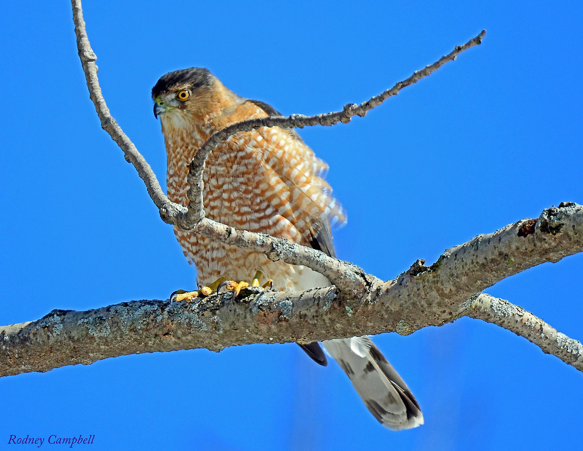
Found worldwide, in all countries aside from Antarctica, the term “hawk” is used to describe over 250 species of diurnal raptors under Order Accipitriformes, which includes hawks, eagles, kites, and ospreys. Raptors, or birds of prey, share some common features such as keen eyesight for hunting prey in the sky or on the ground, sharp, curved beaks and talons used to catch and eat their prey, and as carnivores they provide the ecosystem service of maintaining a balance in the populations of insects, rodents, and other small mammals.
In this Wild Sarasota blog, we will dissect the differences between hawks and falcons. Read on to learn more about our amazing hawks of Florida, or for a more in depth look, visit our Florida Wildlife webpage to watch our Wild Sarasota webinar on Hawks.
Hawk or Falcon?
Often times, the terms “hawk” and “falcon” are used interchangeably, but the truth is they are two different Orders and Families of birds. Hawks belong to the Order Accipitriformes, and more specifically to the Family Accipitridae; while falcons belong to the Order Falconiformes and the Family Falconidae, which includes the Peregrine falcon, American kestrel, the Merlin, and in a separate Genus, the Crested Caracara. This taxonomical separation in classification is an indication of how hawks differ from falcons in several ways. The first being…

Size
Hawks are medium to large sized predatory birds that can reach from anywhere between 18 to 30 inches in length. Falcons are typically small to medium sized birds of prey, ranging from 8-26 inches in length.
The Sharp-shinned Hawk (Accipiter striatus) is an exception to the hawks’ typical size. This is the smallest hawk in both Canada and the United States. Only 9.4 to 13.4 inches in length with a wingspan between 16.9 to 22.1 inches, this tiny hawk is an extremely acrobatic flyer that preys upon songbirds and mice.

The largest hawk in North America is the Ferruginous Hawk (Buteo regalis). This bird can reach up to 27 inches in length and have a wingspan up to 55 inches across. This spectacular hawk can be found scanning the open grasslands of the west looking for its prey.
Wing shape and flight pattern
In comparison to falcons, hawks have a wider, more rounded wing shape, and a shorter wingspan to size ratio. Their wingspans can reach between 17 and 44 inches. The wings of a hawk are built for hovering as they look for prey far below on the ground. The wings of a falcon tend be more narrow, angled, and longer- often referred to as scythe-shaped. This wing shape is built for speed and maneuvering. It allows for fast, quick, and agile movements in the sky as they pursue their prey of smaller bird species. For instance, peregrine falcons are known for their speedy and accurate dives of up to 200mph, whereas red-tailed hawks are known to dive at a maximum speed of 120mph.
A keen eye could spot the difference between a falcon and a hawk based off of the flight pattern alone. Hawks tend to slowly beat their wings in a flap-flap-glide pattern, utilizing their broad wingspan for soaring. While falcons can be seen quickly fluttering their wings in a speedier flight pattern.
Beaks and eyes
Not as noticeable from a afar are two more differences between hawks and falcons. Although both have strong, sharp, curved beaks, falcons have an extra notch or “tooth” at the base of their beak that hawks do not. Falcons catch their prey in flight (known as “on the wing”) and use this “tooth” to kill their prey quickly, whereas hawks more often use their talons to dispatch their prey.
Generally, hawks have yellow eyes, while falcons generally have brown eyes.
North American Hawks

Across the country, there are 19 different species of hawks circling through the air. The most common of them being the Red-tailed Hawk (Buteo jamaicensis). This hawk is quite large, with a wingspan of 44.9 to 52.4 inches. Spot this hawk soaring high, in wide circles over open country areas.
The title of the rarest hawk in the United States goes to… the Short-tailed Hawk (Buteo brachyurus). Throughout North America, this bird has a population of only 500 or less and is only found right here in Florida. If you happen to notice one of these hawks soaring the sky, scanning for prey, expect to see a dark morph with blackish-brown plumage contrasting with a silver-white coloration on the wings and tail.
The hawks that make Florida their home include the red-tailed and short-tailed hawks, but also the more common in Florida red-shouldered hawk, and the less commonly seen northern harrier, Cooper’s hawk, and sharp-shinned hawk.

Hawks and Our Ecosystems
Hawks play an important role within our local ecosystems. They are raptors, or birds of prey, meaning they hunt and prey upon other birds, insects, snakes, lizards, and small mammals. This keeps the population of small mammals, such as rabbits, mice, and other rodents under control. This not only helps maintain balance within the food web, but hawks will often hunt for their prey over agricultural fields and in residential areas, providing a benefit to our farmers, crop production, and homes.
Most hawks make their own nests, but once they leave the nest, it continues to provide habitat for owls or other smaller bird species.
To learn more about the unique identifying characteristics and lifestyles of the species of hawks that make Florida their home, watch our Wild Sarasota webinar on hawks which can be found on our Florida Wildlife webpage.
Read all our Wild Sarasota blogs here
 0
0
